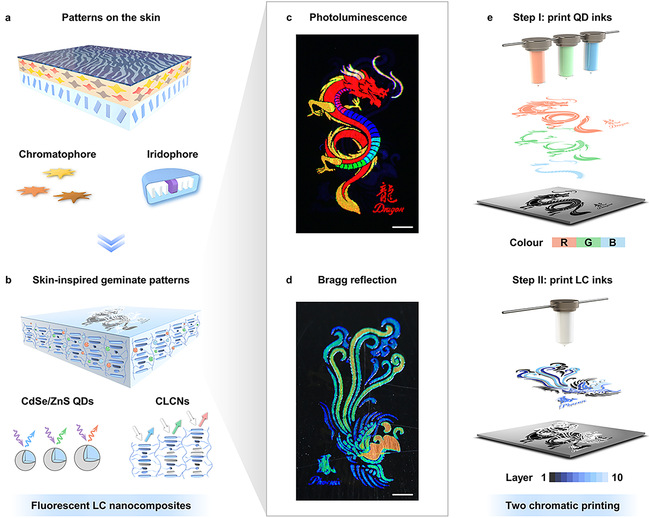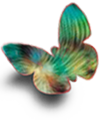Search
Title: Two-Chromatic Printing Creates Skin-Inspired Geminate Patterns Featuring Crosstalk-Free Chemical and Physical Colors
Author: Xiaojun Liu, Shuzhen Cui, Lang Qin*, Yanlei Yu*
Journal: Adv. Optical Mater., 2024, 12, 2302573
Abstract:
Skin-inspired optical materials that combine both chemical and physical colors provide enhanced information capacity for potential applications in optical multiplexing and anti-counterfeiting technologies. However, the existing materials suffer from the limitations of an extremely narrow gamut and incompatibility with universal patterning methods to program dual-mode images. Here, novel two-chromatic printing technology is proposed to create full-color, high-resolution, and geminate patterns by newly designed fluorescent liquid crystal nanocomposites. Such nanocomposites consist of porous cholesteric liquid crystal networks embedded with core–shell CdSe/ZnS quantum dots to produce extended wide color palettes of both photoluminescence and Bragg reflection. The drop-on-demand two-chromatic printing technology simultaneously enables the construction and patterning of the nanocomposites in a high-precision way, orthogonally tuning the hues of two color palettes according to Grassmann's and Bragg's law. Therefore, the combination of different color generation mechanisms offers a versatile toolbox, which can be generalized to pigmentary, photonic, and even dynamic optical materials.
Fulltext Link: https://onlinelibrary.wiley.com/doi/10.1002/adom.202302573

In this work, a fluorescent liquid crystal nanocomposite was designed by combining quantum dots, liquid crystal mixture and porous cholesteric liquid crystal polymer network. Among them, the core-shell CdSe/ZnS quantum dots provided fluorescence color, and the liquid crystal mixture was used to regulate the periodic molecular arrangement of the cholesteric liquid crystal polymer network to change the reflection wavelength. Since the porous polymer network stabilized the arrangement of liquid crystal molecules while reserving space for quantum dots, the independent regulation of fluorescence color and reflection wavelength was ensured. With the help of high-precision inkjet printing technology, quantum dots and liquid crystal mixture were gradually selectively introduced into the polymer network to edit the pattern, and the fluorescence color was regulated according to the law of color and light mixing to cover the sRGB color gamu, and the reflection wavelength was regulated according to Bragg's law to cover the visible light region, and finally a full-color, high-resolution (300 dpi) reflection/fluorescence dual label was constructed. This work breaks through the limitations of fluorescent liquid crystal materials with few fluorescent colors and difficult local accurate regulation of liquid crystal molecule arrangement and distribution, and opens up a new development idea for the dual patterning of fluorescent materials and photonic crystals.







